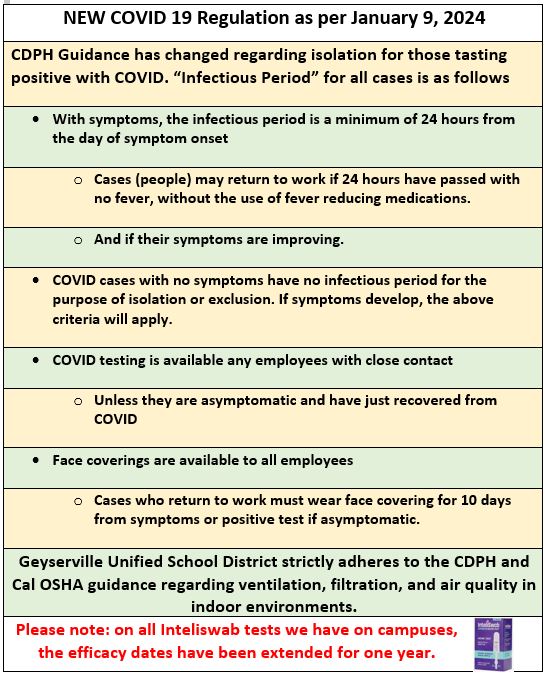Covid-19 Updates and Information
|
NEW COVID 19 Regulation - January 9, 2024
CDPH Guidance has changed regarding isolation for those tasting positive with COVID. “Infectious Period” for all cases is as follows
Please note: on all Inteliswab tests we have on campuses, the efficacy dates have been extended for one year. |
GUSD COVID Testing Framework
Testing for COVID-19 remains an essential tool to decrease transmission, keep students and staff safe, and keep schools open for in-person instruction while mitigating the COVID-19 pandemic.
CDPH strongly recommends that schools facilitate access to testing, particularly for vulnerable populations within their communities. Testing, especially of symptomatic individuals and those exposed to a positive COVID-19 case, remains an important for minimizing transmission and keeping students in the classroom for in-person instruction.
GUSD has adopted the CDPH Guidelines as a safe tactic for keeping students, families, and staff healthy.
Click here for the Public Health Guidance for K–12 Schools and Child Care Settings to Support Safe In-Person Services and Mitigate the Spread of Communicable Diseases, 2023-2024 School Year
Click here for Frequently Asked Questions around K-12 Testing Framework - Updaed August 29, 2023
See the 2023-2024 Protocol below. Geyserville Schools will have OTC test available to families while supplies last and to staff for the duration of the OSHA requirement. Please call your school's front office if you are in need of a kit.
GUSD schools will not administer tests to students.
CDPH strongly recommends that schools facilitate access to testing, particularly for vulnerable populations within their communities. Testing, especially of symptomatic individuals and those exposed to a positive COVID-19 case, remains an important for minimizing transmission and keeping students in the classroom for in-person instruction.
GUSD has adopted the CDPH Guidelines as a safe tactic for keeping students, families, and staff healthy.
Click here for the Public Health Guidance for K–12 Schools and Child Care Settings to Support Safe In-Person Services and Mitigate the Spread of Communicable Diseases, 2023-2024 School Year
Click here for Frequently Asked Questions around K-12 Testing Framework - Updaed August 29, 2023
See the 2023-2024 Protocol below. Geyserville Schools will have OTC test available to families while supplies last and to staff for the duration of the OSHA requirement. Please call your school's front office if you are in need of a kit.
GUSD schools will not administer tests to students.
Parent and Family Resources
County Office of Education Covid-19 updates
Mental Health Resources
California Health Resources
Information concerning the Corona virus
Mental Health Resources
California Health Resources
Information concerning the Corona virus
2023-2024 Protocol
If a Student is Symptomatic and/or has a Fever at School
Send student to the office.
1. If the student has a fever, the student must go home.
2. Offer the parent a single OTC test kit.
3. School staff MAY NOT administer OTC tests.
Only a parent/guardian can administer. THIS IS THE LAW.
4. With no fever, a mildly symptomatic student who tests negative may return to class at the discretion of the principal.
5. A student with a fever who tests negative must remain at home until 24 hours after the fever is gone.
– No specific timeline for return.
If a Student is Symptomatic and/or has a Fever at School
Send student to the office.
1. If the student has a fever, the student must go home.
2. Offer the parent a single OTC test kit.
3. School staff MAY NOT administer OTC tests.
Only a parent/guardian can administer. THIS IS THE LAW.
4. With no fever, a mildly symptomatic student who tests negative may return to class at the discretion of the principal.
5. A student with a fever who tests negative must remain at home until 24 hours after the fever is gone.
– No specific timeline for return.
FREQUENTLY ASKED QUESTIONS (FAQ'S) REGARDING COVID-19
HOW DO I KNOW IF MY OTC TEST WILL STILL WORK?
Please note: on all Inteliswab tests we have on campuses, the efficacy dates have been extended for one year.
Follow this link for
General Information About
At-Home OTC COVID-19 Diagnostic Tests
Please note: on all Inteliswab tests we have on campuses, the efficacy dates have been extended for one year.
Follow this link for
General Information About
At-Home OTC COVID-19 Diagnostic Tests
|
Right now, there are few restrictions for COVID cases.
The following is our protocol Q: My child is sick with symptoms of COVID-19 - what do I do?
Q: Do children who are asymptomatic, but tested positive for the virus, have to quarantine? A: Absolutely, yes, that is the guidance. They must quarantine for a total of 24 hours and may return after 24 total hours with no fever and milder symptoms. |
Historical GUSD COVID Safety Plans
COVID Plan Amendment 2-9-22
COVID Plan Additional Face Covering Amendment 3.1.22
GUSD COVID Prevention Program (CPP) August 28, 2021
Programa de Prevención de COVID-19 (CPP, por sus siglas en inglés)Distrito Escolar Unificado Geyserville


